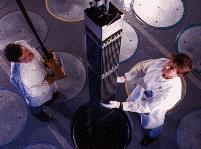Areva has refuted claims that its MOX nuclear fuel assemblies failed in-core tests essential to the US program to use the fuel, which would be made in part from dismantled nuclear weapons.
 |
| Handling a MOX fuel assembly |
Plutonium oxide recovered from 'surplus' nuclear weapons can be combined with uranium oxide as mixed oxide (MOX) nuclear fuel for use in commercial light-water reactors. The US Department of Energy (DoE) has 34 tonnes of plutonium it wishes to use in this way and is constructing a dedicated $4.8 billion plant to manufacture MOX fuel at Savannah River.
A necessary step before MOX fuel assemblies can be used in the USA is a long-term in-core test. France's Areva supplied four MOX 'lead test assemblies' for the trial, carried out at the first reactor of Duke Energy's Catawba nuclear power station. The ultimate plan would be to use 20-40% MOX fuel loads in the four reactors at Catawba and McGuire from around 2010.
This plan was cast into doubt on 4 August by a statement from Friends of the Earth and the Union of Concerned Scientists, which they said was based on a report from Duke Energy detailing the results of the second inspection of the MOX assemblies.
The activists' statement said that the fuel had become excessively elongated and now posed a safety hazard. Furthermore, the apparent failure of the fuel would necessitate Areva re-designing the assemblies and a complete repeat of the in-core test. This, they said, would put the MOX program back by at least eight years - and therefore it should be scrapped. The integrity of fuel assemblies is important in nuclear safety, as the metal alloys that contain the highly-radioactive used fuel constitute the second barrier between the dangerous material and the environment. The first barrier is the insoluble ceramic structure of the fuel pellets, while further barriers come from power plant structures and systems - including a reinforced concrete containment.
Areva today refuted the claims. Spokesman Jarret Adams told World Nuclear News that the assemblies completed their test run after their second 18-month operating cycle. At that point, an inspection revealed that they had "extremely slight" growth beyond an acceptance limit, defined separately from safety limits. Fuel assemblies for a pressurized water reactor like Catawba 1 are typically around four metres long and feature springs to accommodate the thermal expansion of around 15mm expected during their lifetimes in the reactor core.
It had been planned to use the assemblies once again for a third operating cycle to gain more data, and Adams said Duke was still considering this.
Delays to the program could be costly for the DoE, but the initiative is seen as too advanced to cancel. The 34 tonnes of 'surplus' former weapons material is to be destroyed according to an agreement with Russia which will see equivalent amounts in both countries used for power generation. In total, some 400 billion kWh of electricity could be generated by the materials.
Work has already started on the Savannah River MOX plant, which Areva is constructing with Shaw, and it could begin operation from 2016. It was originally agreed that Russia would also build a MOX fuel plant, but officials would now prefer to use the plutonium in starter fuel for fast breeder reactors instead.





_91467.jpg)
_47120.jpg)
_16439.jpg)





